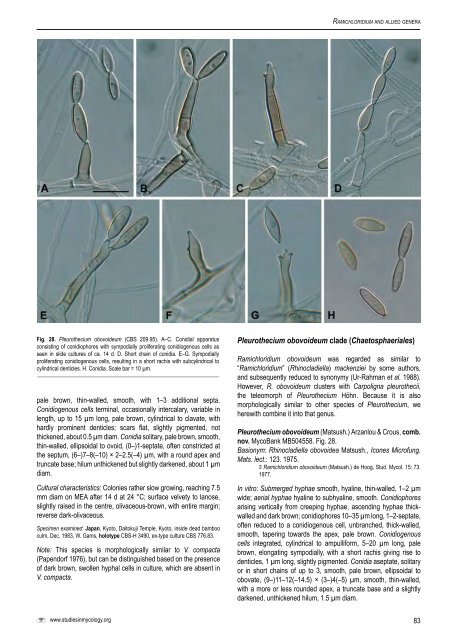The genus Cladosporium and similar dematiaceous ... - CBS - KNAW
The genus Cladosporium and similar dematiaceous ... - CBS - KNAW
The genus Cladosporium and similar dematiaceous ... - CBS - KNAW
You also want an ePaper? Increase the reach of your titles
YUMPU automatically turns print PDFs into web optimized ePapers that Google loves.
Ramichloridium <strong>and</strong> allied genera<br />
Fig. 28. Pleurothecium obovoideum (<strong>CBS</strong> 209.95). A–C. Conidial apparatus<br />
consisting of conidiophores with sympodially proliferating conidiogenous cells as<br />
seen in slide cultures of ca. 14 d. D. Short chain of conidia. E–G. Sympodially<br />
proliferating conidiogenous cells, resulting in a short rachis with subcylindrical to<br />
cylindrical denticles. H. Conidia. Scale bar = 10 µm.<br />
pale brown, thin-walled, smooth, with 1–3 additional septa.<br />
Conidiogenous cells terminal, occasionally intercalary, variable in<br />
length, up to 15 µm long, pale brown, cylindrical to clavate, with<br />
hardly prominent denticles; scars flat, slightly pigmented, not<br />
thickened, about 0.5 µm diam. Conidia solitary, pale brown, smooth,<br />
thin-walled, ellipsoidal to ovoid, (0–)1-septate, often constricted at<br />
the septum, (6–)7–8(–10) × 2–2.5(–4) µm, with a round apex <strong>and</strong><br />
truncate base; hilum unthickened but slightly darkened, about 1 µm<br />
diam.<br />
Cultural characteristics: Colonies rather slow growing, reaching 7.5<br />
mm diam on MEA after 14 d at 24 °C; surface velvety to lanose,<br />
slightly raised in the centre, olivaceous-brown, with entire margin;<br />
reverse dark-olivaceous.<br />
Specimen examined: Japan, Kyoto, Daitokuji Temple, Kyoto, inside dead bamboo<br />
culm, Dec. 1983, W. Gams, holotype <strong>CBS</strong>-H 3490, ex-type culture <strong>CBS</strong> 776.83.<br />
Note: This species is morphologically <strong>similar</strong> to V. compacta<br />
(Papendorf 1976), but can be distinguished based on the presence<br />
of dark brown, swollen hyphal cells in culture, which are absent in<br />
V. compacta.<br />
Pleurothecium obovoideum clade (Chaetosphaeriales)<br />
Ramichloridium obovoideum was regarded as <strong>similar</strong> to<br />
“Ramichloridium” (Rhinocladiella) mackenziei by some authors,<br />
<strong>and</strong> subsequently reduced to synonymy (Ur-Rahman et al. 1988).<br />
However, R. obovoideum clusters with Carpoligna pleurothecii,<br />
the teleomorph of Pleurothecium Höhn. Because it is also<br />
morphologically <strong>similar</strong> to other species of Pleurothecium, we<br />
herewith combine it into that <strong>genus</strong>.<br />
Pleurothecium obovoideum (Matsush.) Arzanlou & Crous, comb.<br />
nov. MycoBank MB504558. Fig. 28.<br />
Basionym: Rhinocladiella obovoidea Matsush., Icones Microfung.<br />
Mats. lect.: 123. 1975.<br />
≡ Ramichloridium obovoideum (Matsush.) de Hoog, Stud. Mycol. 15: 73.<br />
1977.<br />
In vitro: Submerged hyphae smooth, hyaline, thin-walled, 1–2 µm<br />
wide; aerial hyphae hyaline to subhyaline, smooth. Conidiophores<br />
arising vertically from creeping hyphae, ascending hyphae thickwalled<br />
<strong>and</strong> dark brown; conidiophores 10–35 µm long, 1–2-septate,<br />
often reduced to a conidiogenous cell, unbranched, thick-walled,<br />
smooth, tapering towards the apex, pale brown. Conidiogenous<br />
cells integrated, cylindrical to ampulliform, 5–20 µm long, pale<br />
brown, elongating sympodially, with a short rachis giving rise to<br />
denticles, 1 µm long, slightly pigmented. Conidia aseptate, solitary<br />
or in short chains of up to 3, smooth, pale brown, ellipsoidal to<br />
obovate, (9–)11–12(–14.5) × (3–)4(–5) µm, smooth, thin-walled,<br />
with a more or less rounded apex, a truncate base <strong>and</strong> a slightly<br />
darkened, unthickened hilum, 1.5 µm diam.<br />
www.studiesinmycology.org<br />
83

















